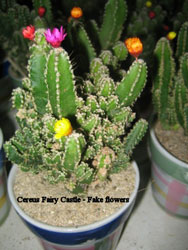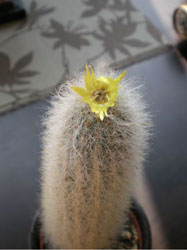Cactus Flowers - Fake or Real?
On the cacti forum, this is a common situation: A person, new to cactus growing, posts a picture of their "flowering"
cactus plant in the identification section. Often times they are quite proud of their long-lasting and attractive blooms. As more seasoned growers
respond to the post, they point out that the flowers are, in fact, glued on and not flowers produced by the cactus plant. Now confused
and embarrassed, the new cactus grower often insists that the flowers are real because they open and close. Further prompted by those who
have "been there, done that", the novice grower investigates further and eventually comes to the realization that the flowers are
indeed held on by glue. At this point, the feeling of excitement, since replaced by embarrassment, now becomes anger and
inevitably the question follows, "Why would anyone do that?".

1. Various cacti and succulents for sale with glued-on flowers
In this article, I will discuss the details of this practice including: -what it is, -how to identify it, -what to do about it, and I will even point out
an positive outcome from this obvious deception. In doing so, I hope to put at ease those who feel they were duped by pointing out just how common it is to
fall for this trick and educating them on future purchases.

|
2. At left, a Cereus with different colored straw flowers.
3. At right, a small Cleistocactus with a single glued-on flower at the top.
|

|
One reason that so many people are confused by this, is that the flowers are not actually "fake", but real. Technically it is an inflorescence, but
for practical reasons, I refer to them as flowers in this article. They can come from one of several species of plant commonly known as
"Strawflowers" or "Everlastings". These are so named because when dried, these flowers have a crisp,
straw-like texture and last for many months. They come in a variety of colors, but most the most compelling feature is that they can open and
close based on humidity/moisture despite being long dead. For more information on these fascinating plants, here are two links with more detailed info:
www.killerplants.com -info on the open/close action
www.howstuffworks.com -info on various species
Now that you know what the impostors are, you will be better equipped to spot one in the store. If you are a novice, just remember those common names: "strawflower" and "everlasting".
Those are both useful descriptive names that are a contrast to real cactus flowers. If it feels papery or straw-like, it isn't a cactus flower.
Likewise, if a single flower lasts more than 1 week, it isn't a cactus flower as most cactus flowers only last a day or two at best. As you progress in you
cactus knowledge, you'll be able to spot a "fake" from a mile away because you'll know what a cactus flower is supposed to look like.
You will also learn where to expect flowers on various cacti - that is not like the picture at the top of this page with flowers stuck all over the place. That
being said, it is sometimes not quite so obvious at first glance. In the picture below, are the flowers "real" or "fake"? The
answer here is "both"! The orange-red flowers are glued on, while the pink flowers are from the plant.

Mammillaria polythele with both "real" and "fake" flowers
I promised an "upside" to this situation, but before discussing that, we will explore the problems. Most obvious of the problems, is
the deception. Clearly, these flowers are glued on to entice the buyer and so the phrase "caveat emptor " is proven once again.
However, aside from getting something that wasn't what it seemed, there is secondary problem that the new owner must face - how to get the
flowers off. While I suspect there are possibly some who don't mind the strawflower/cactus combination, everyone I've encountered can't get
them off fast enough once they've been made aware of the situation.
Sometimes pins are used to attach the strawflowers and those can just be pulled out. There will be damage from the pin sticking the cactus, but
that isn't life-threatening. Most of the time, however, the strawflowers are attached with a hot-glue gun. Simply pulling off a hot-glue flower
is not recommended as it will take the spines and a good chunk of the cactus with it. Again, this is unlikely to kill the cactus plant, but it
will make an unsightly scar. The picture below shows the aftermath of removing a strawflower. In this case it wasn't pulled off, but carefully
removed - illustrating how hard it is to avoid damage. Note also the left-over glue in the spines. One cactus grower highly recommends using an
exacto-knife and heating it on a flame. You then melt/cut the glue off with the hot blade. While not 100% effective, this method seems to
minimize the damage.

At last, I'll discuss the positive outcome based on my own observations. These artificially attached flowers actually act as an "attention
getter" so-to-speak. Many people who would otherwise not give a cactus plant a second look at the garden center, make an impulse purchase
because of the strawflowers. Later on, these people realize they don't know much about their new purchase and seek to identify and
learn how to care for it. It is during this discovery process that they learn the truth about the so-called flower(s). As logic follows,
most want to know what the real flower is supposed to look like. While short-lived, the real flowers are many times more impressive and
the new grower wants to know how to get the plant to flower for real. Before long, they are back at the store looking for more cacti to
purchase. Hence, the impulse buy based on a deception, introduces another new person to the world of cacti that otherwise wouldn't have had
anything to do with them. After all, it isn't often that those with large cactus collections are purchasing these plants, but typically those
with no previous cactus experience.
In conclusion, if you have just found out the hard way that your cactus isn't actually flowering non-stop for you, do not dismay! Remember, many
others have experienced the same disappointment. More importantly, you have now been introduced to the
wonderful world of cacti and are ready to embark on a very rewarding hobby that you might otherwise have missed!
Author: Daiv Freeman
Photo Credits: Pics 1 & 2 -Buck Hemenway, Pic 3 -vsorge17, Pics 4 & 5 -StrUktO
|